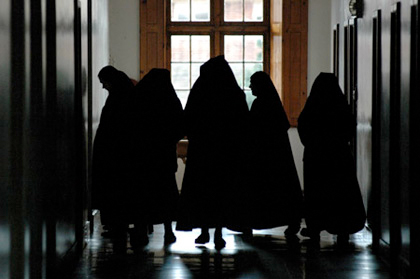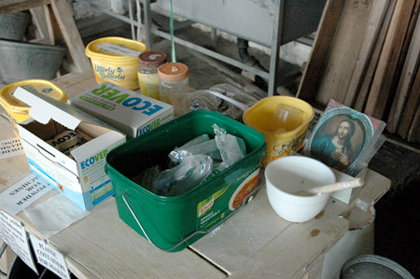Interview
The big wait: Michael Whyte’s
No Greater Love

Michael Whyte found his faith tested when he set out to make No Greater Love, a documentary about Carmelite nuns in Notting Hill. He tells Tom Dawson about how he gained an audience
It took the British film-maker Michael Whyte some ten years to persuade the Carmelite nuns of the Most Holy Trinity monastery in Notting Hill to participate in his absorbing documentary about life in their cloistered community. Back in 1999 local resident Whyte dropped a note into their letterbox in St Charles Square, asking them if they would be interested in taking part in a film. Several weeks later he received a reply saying that it was an interesting idea, but that it wasn’t the right time. He followed up with several more requests over the next decade, receiving similar responses until in November 2007 the Prioress Sister Mary of Saint Philip telephoned and suggested a meeting. Given that men (apart from priests) are not allowed inside the monastery, Whyte spoke to the Prioress and two of her colleagues through a grille in the lodge attached to the institution.
"They asked me what kind of film I was going to make. I said that I didn’t have a clue, because I didn’t know what happened there," recalls Whyte, whose career in directing television documentaries and dramas stretches back to the early 1970s. "I wanted it to reflect their way of life honestly in a way that wouldn’t disrespect them. I said I didn’t want them to lose their dignity, and that I would be happy to show them the film as it goes along or after it had been shot, so that they could correct any errors and misrepresentations." A democratic vote amongst the nuns ensued, and within a week Whyte was filming No Greater Love within the monastery itself.
Shooting on digital video and acting as a one man-crew, he was initially doubtful that he would find enough material to make a 90-minute feature. He shot the daily routines of the nuns, who wake up each day at 5.20am and are only allowed to speak during two recreation periods; alongside prayers and services, there was also cooking, bread-making, cleaning, sewing and gardening to film. "I found the rhythms of their activities mesmerising," he explains, "and realised that the viewer could watch them without a voice-over telling them what was happening. But I still didn’t think the film would last more than about ten minutes."

It was at this point that Whyte decided to ask the nuns to be interviewed on camera. He began with the Prioress, who had joined the monastery as a young Cambridge graduate, and who candidly admits to having wrestled with her own faith for some 18 years whilst in holy orders, before achieving a spiritual breakthrough. "I put the rushes of the interview on a DVD, so she could watch it on her own on the computer," Whyte remembers. (There are no televisions, radios, newspapers or mobile phones at the Most Holy Trinity.) "I’m not sure she showed it to the other sisters, or discussed it with them. She told me she was happy with it, and others then agreed to go on camera, although one of my favourites, Sister Luke, who you see wielding the chainsaw in the garden, couldn’t be persuaded."
It’s these interviews which give No Greater Love such a distinctive feel, helping differentiate it from Philip Gröning’s more abstract study of Carthusian monks, Into Great Silence. The nuns here talk eloquently about the difficulties of maintaining an existence of religious contemplation and affirm their belief in the value of silence and prayer. As Sister Mary of Saint Joseph testifies, "Life in a monastery is not an escape from reality. You are brought face to face with yourself." And Whyte believes that these observations "might well take people by surprise. They might expect that there is a party line and that there are no doubts whatsoever. The Prioress, though, somebody who has committed her whole life to faith, is prepared to say that she might be wrong and the atheists might be right."
I ask the director whether Frederick Wiseman’s observational institutional documentaries had influenced his approach to filming No Greater Love, in particular his decision to avoid any voice-over commentary. "When I started out as a director, I was definitely aware of Wiseman’s films, and although they seemed a very pure form of film-making, I did have a slight problem with them," he replies. "You can come to them with your own prejudices and preconceptions and have them reinforced. I like the way that in film interviews people may step outside the role that has been assigned to them, and you can see a different aspect to the person. I remember when I made a film about seriously dysfunctional children in institutions, Billy. Jimmy. Aycliffe. Trilogy, I wanted to know what it felt like for the staff when crisis situations calmed down. I couldn’t get that simply by observing. I had to speak to them."
On the day of our interview, Whyte had popped in to see one of the nuns from No Greater Love, who is seriously ill in hospital. With filming completed he’s no along allowed to enter the monastery himself, yet he hopes to stay in touch with the women he filmed over the course of a year. "It’s funny," he smiles. "There have been a lot of times when I’ve made documentaries, when I’ve been relieved to leave the place where I was filming. This time I didn’t want to say goodbye. At the beginning I thought they might be austere, humourless and disciplinarian, and they turned out to be delightful: humorous, warm and self-deprecatory. I even accidentally found out one day they were praying for me and my family and for everyone else in the square. They have a completely different set of values, which make you question your own. I wish I was more like them."
No Greater Love is released on 9 April and reviewed in the May issue of Sight & Sound
See also
Lourdes reviewed by Michael Brooke (April 2010)
Into Great Silence reviewed by Catherine Wheatley (February 2007)
The Cup reviewed by Geoffrey Macnab (December 1999)
